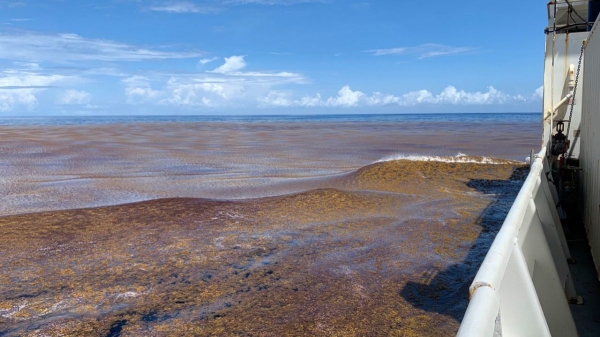Opportunistic sampling shows geographic scope of distribution, offer some of the first sampling opportunities.
Scientists aboard a U.S. research vessel in the tropical Atlantic are taking advantage of the ship’s long-planned path through the Great Atlantic Sargassum Belt to take some of the first samples from a massive, ongoing bloom. Photos and video from the ship show the algae mats on the surface of the eastern Atlantic in the belt that extends from west Africa to the Gulf of Mexico.
This opportunistic sampling is taking place on the National Oceanic and Atmospheric Administration (NOAA) ship, Ronald H. Brown, which set sail from Port Suape, Brazil on March 6 as part of the Global Ocean Ship-based Hydrographic Investigations Program (GO-SHIP), funded by both NOAA and the National Science Foundation. The international program brings together scientists to develop a globally coordinated network as part of the global ocean/climate observing system. The Sargassum sampling illustrates how scientists aboard research vessels can quickly respond to oceanographic phenomena of wide-spread societal importance in real time. “This has been a great way to leverage the measurements we were already making in the region” said Ellen Park, a graduate student who authored a blog on the team’s efforts.
Read more at: Woods Hold Oceanographic Institute
Scientists aboard the NOAA ship Ronald H. Brown in the tropical Atlantic are taking advantage of the ship’s long-planned path through the Great Atlantic Sargassum Belt to take some of the first samples from a massive, ongoing bloom. Photos and video from the ship show the algae mats on the surface of the eastern Atlantic in the belt that extends from west Africa to the Gulf of Mexico. (Photo Credit: Ellen Park ©Woods Hole Oceanographic Institution)


